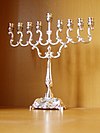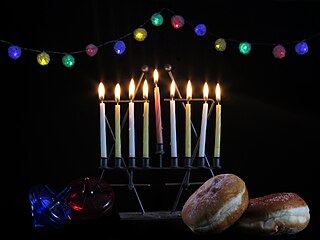
Hanukkah is a Jewish festival commemorating the recovery of Jerusalem and subsequent rededication of the Second Temple at the beginning of the Maccabean Revolt against the Seleucid Empire in the 2nd century BCE.
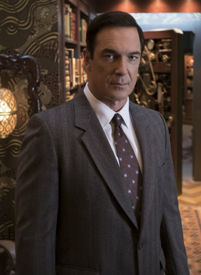
Lemony Snicket is the pen name of American author Daniel Handler. Handler has published several children's books under the name, most notably A Series of Unfortunate Events, which has sold over 60 million copies and spawned a 2004 film and TV series from 2017 to 2019. Lemony Snicket also serves as the in-universe author who investigates and re-tells the story of the Baudelaire orphans in A Series of Unfortunate Events.
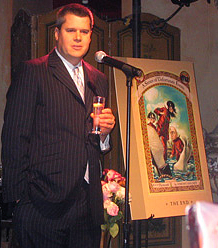
Daniel Handler is an American author, musician, screenwriter, television writer, and television producer. He is best known for his children's book series A Series of Unfortunate Events and All the Wrong Questions, published under the pen name Lemony Snicket. The former was adapted into a film in 2004 as well as a Netflix series from 2017 to 2019.

A Series of Unfortunate Events is a series of thirteen children's novels written by American author Daniel Handler under the pen name Lemony Snicket. The books follow the turbulent lives of orphaned siblings Violet, Klaus, and Sunny Baudelaire. After their parents' death in a fire, the children are placed in the custody of a murderous villain, Count Olaf, who attempts to steal their inheritance and causes numerous disasters with the help of his accomplices as the children attempt to flee. As the plot progresses, the Baudelaires gradually confront further mysteries surrounding their family and deep conspiracies involving a secret society.

A latke is a type of potato pancake or fritter in Ashkenazi Jewish cuisine that is traditionally prepared to celebrate Hanukkah. Latkes can be made with ingredients other than potatoes such as cheese, onion, carrot, and zucchini.

A Hanukkah menorah, or hanukkiah, is a nine-branched candelabrum lit during the eight-day Jewish holiday of Hanukkah. Eight of the nine branches hold lights that symbolize the eight nights of the holiday; on each night, one more light is lit than the previous night, until on the final night all eight branches are ignited. The ninth branch holds a candle, called the shamash, which is used to light the other eight.

Sufganiyah is a round jelly doughnut eaten in Israel and around the world on the Jewish festival of Hanukkah. The doughnut is deep-fried, injected with jam or custard, and then topped with powdered sugar. The doughnut recipe originated in Europe in the 16th century, and by the 19th century was known as a Berliner in Germany. Polish Jews, who called it a ponchik, fried the doughnut in schmaltz rather than lard due to kashrut laws. The ponchik was brought to Israel by Polish Jewish immigrants, where it was renamed the sufganiyah based on the Talmud's description of a "spongy dough".
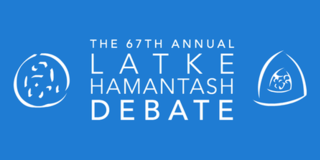
The Latke–Hamantash Debate is a deliberately humorous academic debate about the relative merits and meanings of these two items of Ashkenazi Jewish cuisine. The debate originated at the University of Chicago in 1946 and has since been held annually. Subsequent debates have taken place at several other universities. Participants in the debate, held within the format of a symposium, have included past University of Chicago president Hanna Holborn Gray, philosopher Martha Nussbaum, former Council of Economic Advisers Chairman Austan Goolsbee, Nobel Prize winners Milton Friedman, George Stigler, Leon M. Lederman, and essayist Allan Bloom. A compendium of the debate, which has never been won, was published in 2005.
Hanukkah music contains several songs associated with the festival of Hanukkah.

Hanukkah gelt, also known as gelt, is money given as presents during the Jewish festival of Hanukkah. It is typically given to children and sometimes teachers, often in conjunction with the game of Dreidel. In the 20th century, candy manufacturers started selling Hanukkah-themed chocolate coins wrapped in gold or silver foil, as a substitute or supplement to real money gifts.
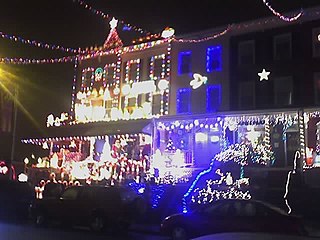
In Baltimore, Maryland, Miracle on 34th Street is a display of holiday lights that takes place annually on the 700 block of 34th Street (between Chestnut Avenue and Keswick Road in Baltimore's Hampden community. The display, which involves the residents of most of the houses on the block, started in 1947, and takes place between late November and late December. The location becomes a major attraction for visitors from all over the area.

This is a list of books by Lemony Snicket, the pen name of American author Daniel Handler. Works published under the name Daniel Handler are not included. Handler, as Snicket, has published 26 fiction novels, thirteen in the main A Series of Unfortunate Events franchise. His works have been translated into more than 40 languages, and have sold more than 65 million copies.
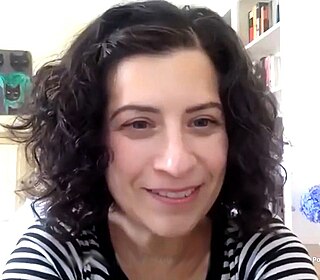
Lisa Michelle Brown is an American illustrator and writer whose books include Picture the Dead,How To Be,The Latke Who Couldn’t Stop Screaming, and Baby, Mix Me A Drink. She draws the Three Panel Book Review cartoon for the book section of the San Francisco Chronicle. She graduated with a BA from Wesleyan University in Middletown, Connecticut in 1993, and an MS in Communications Design from the Pratt Institute in Brooklyn, New York in 1998. She lives in San Francisco with her son and her husband, Daniel Handler.

The White House Hanukkah Party is an annual reception held at the White House and hosted by the U.S. President and First Lady to recognize and celebrate the Jewish festival of Hanukkah. The tradition was established in 2001, during the administration of George W. Bush. The guest list includes hundreds of American Jewish politicians, organization heads, and school and yeshiva deans.

A Hanukkah bush is a bush or tree—real or artificial—that some Jewish families in North America display in their homes for the duration of Hanukkah. It may, for all intents and purposes, be a Christmas tree with Jewish-themed ornaments. It is associated with Chrismukkah.
Thanksgivukkah is a holiday name portmanteau neologism given to the convergence of the American holiday of Thanksgiving and the first day of the Jewish holiday of Hanukkah on Thursday, November 28, 2013. It was the result of a rare coincidence between the lunisolar Hebrew calendar and the Gregorian calendar. Because the calendars are not calculated the same way, Hanukkah appears from year to year on different dates on the Gregorian calendar, ranging from late November to early January.

Miracle of the cruse of oil, or the Miracle of Hanukkah, is an Aggadah depicted in the Babylonian Talmud as one of the reasons for Hanukkah. In the story, the miracle occurred after the liberation of the Temple in Jerusalem during the Maccabean Revolt, and it describes the finding of a jug of pure oil that was to be enough to light the lamp for one day, but that lasted for eight days.

Latke, the Lucky Dog is a 2014 holiday-themed children's picture book written by Ellen Fischer and illustrated by Tiphanie Beeke. The story is about a mixed-breed dog, named Latke, who is adopted from an animal shelter for a Hanukkah present.
A Hanukkah film is a genre of film in which the main emphasis is on the celebration of the Jewish holiday of Hanukkah. Films in this style traditionally incorporate the religious aspects of Hanukkah, such as lighting the menorah and the story of the Maccabees, as well as the cultural aspects of Hanukkah, such as spinning dreidels, or eating traditional foods such as latkes, sufganiyot, or gelt. Films in this genre are typically similar to comedy and romantic comedy films in content, however some are similar in style to action, drama, and animated films, among other genres. Hanukkah films are more commonly produced in the United States, however, they are also produced in other countries such as Israel.
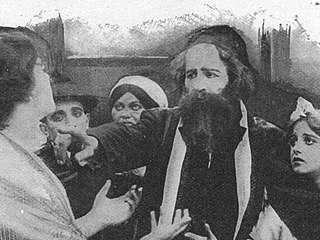
Throughout the history of Christianity, Jewish peoples have been historically religious minorities in countries that were majority or even officially Christian. Over time, a unique relationship evolved between the Jews and the major Christian holiday of Christmas, including the creation of separate traditions and the intersection of Hanukkah and Christmas, among other convergences. Some practices perpetuate out of a feeling of otherness, while others are merely lighthearted activities that are accessible when shops are closed around Christmastime.

















